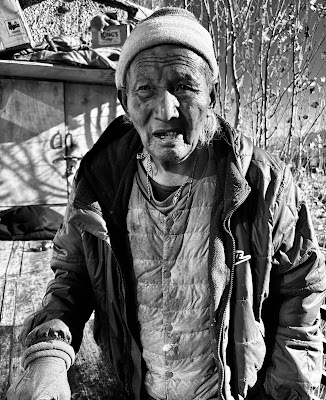Lobzang Tsewang le, now eighty-two, recalls that Tangtse was once among the most fertile areas in the region. Villagers from Phobrang and the Sato Kargyam tract, where cultivation had long been impossible due to the severity of the cold, regularly visited to barter wool, livestock, and meat for Tangyar’s barley. With recent changes in climate, these villages too have begun cultivating barley and other crops, though only on a modest scale.
In earlier times, the main access to Tangtse was via Chang La, a route suitable for both sheep and horses. Kela Pass offered an alternative, but its difficulty confined it to horse caravans bound for Leh or Sakti. Even when villagers returned from Sakti or Leh with purchased goods, they preferred to cross back through Chang La. Another approach to Nubra lay through Neebuk La, while a lesser-known passage via Shachukul Monastery led to Tukla in Rong.
Until Tsewang was in his thirties, people from Spangmik, Man, and Merak—settlements along Pangong—still sourced salt directly from the northern shores of the lake. Families who lived in rebos along the water’s edge drove their sheep to a site called Rundo, situated just before Rudok, to collect it. The journey was timed with the onset of winter, when Pangong froze over. Once the ice formed, villagers could cross the lake directly to its northern side, reducing the distance to Rundo to a fraction of what it would otherwise be through the long detour via Phobrang. Shamma traders also synchronized their movements with this season, travelling across the frozen expanse alongside the Pangong villagers.
On their return from Rundo, the Pangong villagers would halt for a night at Tangtse before carrying salt to Nubra. Instead of taking the present-day Durbuk road, they travelled through Rele Ichen village, crossed the Neebuk La Pass, and entered Nubra at Tangyar. Tsewang remembers purchasing salt from them along the way and joining their caravans. In Nubra, the exchange rate was one unit of salt for four of barley, with the chakkar serving as the standard measure. He first made this journey at the age of twenty-five with his uncle, Aba Phunsog Rigzin, visiting Tangyar, Diskit, and Kubet. The journey was always on horses. Tsewangs family owned 4 horses while there were families of Katley and Thakthyang , the richest in the region who owned14-15 horses. The Tangtse traders often extended their stay in Nubra, where pastures for sheep were plentiful. Hospitality was another attraction: Nubra villagers frequently provided free fodder to visitors. Diskit and Hunder were favored for wheat, while Kubet was renowned for its superior barley.
Tsewang also recalls a curious attempt by some locals to revive salt production near Meerak. Believing that imported salt could act as a fermenting catalyst, they scattered market-bought salt over an old site once known for natural deposits. The experiment failed, yet the episode survives in the region’s salt lore.





.png)


















